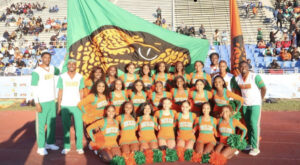
Florida A&M University cheerleaders — highly visible at football and basketball games, and oftentimes at monthly convocations — are the only members of an athletic department team who do not receive any scholarship support.
To make matters worse, cheerleaders for football are expected to pay dues $1,500 at the start of each school year while basketball cheerleader dues are $850, according to current cheerleaders.
What is the difference between other sports and cheer? Some may say the involvement of a ball, and others may say the outfits.
According to NCAA.org, “A sport shall be defined as an institutional activity, sponsored at the varsity or club level, involving physical exertion for the purpose of competition against teams or individuals within an intercollegiate competition structure.”
FAMU cheerleader Sierra Ross believes that cheerleading is indeed a sport.
“I do feel as if people not viewing cheer as a sport has a major part in why we do not get scholarships,” Ross said. “People often do not understand what we as athletes go through when it comes to cheering; just because we are not throwing a football or shooting a basketball does not validate that we are not a sport.”
Brandi Tatum-Fedrick, coach of FAMU’s cheerleading team, did not reply to emails seeking comment and an explanation as to why the athletic department treats the cheer team different from all its other sports.
If you go to the athletic department’s website, you will find cheerleading listed among the women’s sports. FAMU cheerleaders, for whatever reason, do not receive scholarships while they are offered to FAMU students participating in every other sport.
FAMU cheerleader Ashlynn Bole said that a scholarship would make a significant difference financially — even it was only a partial scholarship.
“If swimming can be considered a sport, then cheer where we flip, jump and lift and throw human bodies can be a sport. We risk our lives cheering every day just like football players, so what is the difference?” Bole said.
“We do not get any scholarships. I wish we did because it would help the team and the coaches. There are no monetary incentives; for example, almost everyone who plays another sport gets at least a partial scholarship to help them significantly financially,” Bole said.
“Besides our love for cheer and each other, for the most part, nothing is making us try out again every year. I feel like if we are considered an athletic team, we should be able to receive funds in terms of scholarships just like every other sport like golf, bowling, or football. We compete, train, practice, have teamwork, and have coaches, just like every other athletic team,” Bole added.
While FAMU cheerleaders do not receive any financial relief for their participation on the team, some institutions do provide scholarships for their cheerleaders.
According to ncsasports.org, “Many colleges provide scholarships worth $500 and $1,000 per year to compensate cheerleaders for their participation on the team.”
Broward County-based mother and daughter cheer coaches Veverly Pinkney-Lee and Tenia Gaskin emphasize the financial neglect cheerleaders must deal with.
Pinkney-Lee said, “Many schools do not offer scholarships for cheerleading. If they offer a cheerleading scholarship, it should be considered a sport, but they offer them to other sports and any other athletes.”
“It does not turn into a full career unless you go to a team like the [Dallas] Cowboys. Still, cheer will not make as much money as a football or soccer player,” Gaskin said.